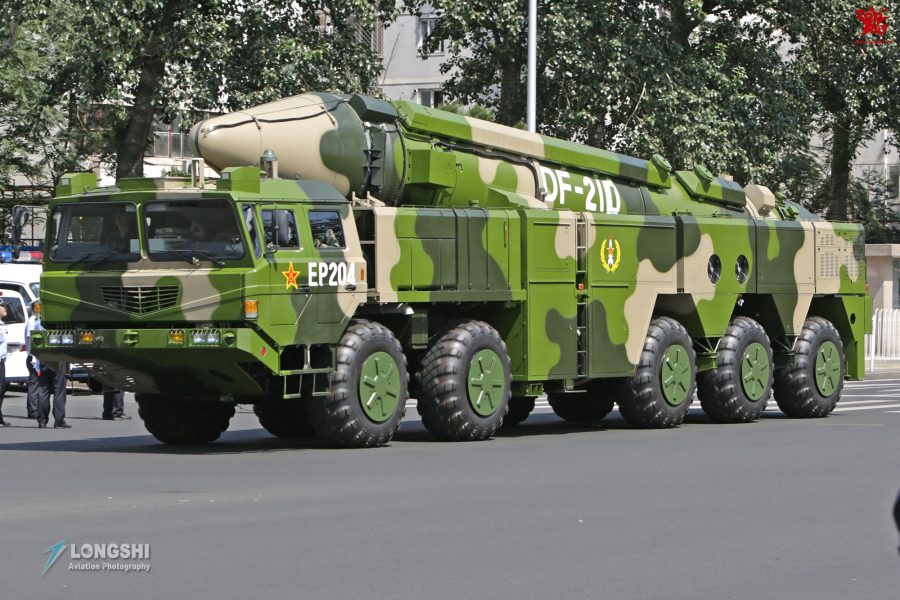China’s diverse range of land attack ballistic and cruise missiles will be the key weapons to pound Taiwanese targets during any invasion. These weapons are deployed by the People’s Liberation Army Rocket Force (PLARF).
PLARF, a separate and dedicated unit, will act independently of the PLA Air Force (PLAAF), PLA Navy (PLAN), and the People’s Liberation Army (PLA), yet have its strikes complement the operations of other military arms.
According to Indian Military analyst Lt. General PR Shankar, the PLARF currently has at least 40 combat missile brigades. These are organized into six “bases,” each of four to eight brigades. The missile bases are numbered 61-66. You can read his comprehensive analysis on PLARF here.
Chinese military analyst Antonio Graceffo outlined how the “clandestine unit” poses a “significant threat to the US and its allies in the Indo-Pacific given the benefits from being a “unique…specialized” rocket and missile-centric “armed service” that has a separate funding and modernization procedures, a personal vision of President Xi Jinping.
The presence of the PLARF does not automatically put the US and its allies at a disadvantage since Washington alone commands a technologically sophisticated navy and air force.
The analyst, however, suggests that PLARF’s role would nevertheless have a massive impact and benefit on China, given the volume and frequency of attacks it can undertake on targets.
‘PLARF Would Strike First & Hard’
Graceffo said that the PLARF would execute precise conventional and nuclear strikes “using its arsenal of missiles,” including 1,000 short-range ballistic missiles, 100 intermediate-range ballistic missiles, and about 600 ground-launched cruise missiles, all with ranges of 1,000km to 1,500km.
The nuclear strike bit seems unlikely as neither Taiwanese nor American official reports or statements have revealed any assessments of China posing an atomic threat to the independently governed island state.
These missiles would target critical defense assets of the Republic of China Air Force (RoCAF). The PLARF would fire from “mobile, ground-based units” using “shoot-and-scoot” tactics that involve moving the launcher after firing to evade counterfire.

A report in the EurAsian Times noted how US and allied bases in the first and second island chains could come under fire with missiles explicitly designed for the purpose. For instance, the DF-16 short-range ballistic missile (SRBM) can reach 1,000 kilometers, bringing all the first island chain targets within reach.
The 1,500-2,000 kilometers range DF-21D ‘carrier killer’ anti-ship ballistic missile (ASBM) can hit the second island chains and any approaching US naval flotilla. The DF-26 intermediate-range ballistic missile (IRBM) can reach 3,500 kilometers, hitting the most crucial yet farthest US naval base in the western Pacific in Guam.
Graceffo added that by 2028, the PLARF is projected to possess more than 1,000 ballistic missile launchers, including at least 507 capable of carrying nuclear payloads, 342 to 432 conventional launchers, and 252 with dual capabilities. “Furthermore, there would be 320 solid-fuel fixed intercontinental ballistic missile (ICBM) silos, with 30 liquid-fuel fixed ICBM silos under construction.”
How Would PLARF Operate?
These figures exclude launchers deployed by the PLA Air Force and the PLA Navy for their missile strikes. This brings about a situation where neither the PLAAF nor the PLAN depends on the PLAARF for missile fire support. They would essentially execute independent operations yet geared towards the same goal of degrading enemy forces.
All enemy material losses eventually benefit a fighting side, even if an individual target is irrelevant for a specific arm or its units (army, naval, or air). For instance, a sustained PLARF campaign against Taiwanese land targets that hold both Taiwanese air force bases or army tactical command centers might be carried out independently without consultation with the PLAAF or PLA.
The same is true for the PLAN in the event PLARF hits Republic of China (RoCN) bases, shore facilities, or land-based coastal defense anti-ship missile batteries. If anything, it spares the PLAN or the PLAAF’s ammunition stockpiles since they would have fewer targets.
Put differently, PLARF’s operations would be coordinated with the PLAAF and PLAN at the strategic level. They would be directed by joint command and control centers of the respective Theater Command for the operational objectives and overseen by a primary overall command and control center deeper in the mainland for meeting broader strategic and political goals.
If the need arises, there might be mechanisms to bring about tactical-level integration between the formation and unit commanders of the PLAAF, PLAN, and the PLARF. But the PLARF’s general inventory and orientation are strategic, suggesting it might aim at larger and heavier targets in the enemy’s rear that cripple operations in the front.
Thus, it is unlikely that the PLARF would be prosecuting smaller, routine land targets. Higher commanders in the Theater Command, who also oversee the PLAAF and the PLAN’s progress, might regulate the PLAAF operations in intensity and timing.
Massive Corruption
Notably, the missile stockpile figures of the PLARF exclude launchers deployed by the PLA Air Force and the PLA Navy. However, the PLARF is also marred by severe corruption charges against its senior ranks.
Last year, China ousted the PLARF head for alleged bribery, along with several top officers and those working in “procurement.” Corruption in the PLA is generally “rampant” in procurement.
Officials are in a position to “skim money” or accept “kickbacks” for awarding contracts to friends and family. The PLARF, central to Xi’s military philosophy and given its “cutting-edge technology,” is prioritized in budgetary funding.
“It would be a mistake to believe that the corruption uncovered in the PLARF suggests that the branch is ineffective or less of a threat. If anything, that the leadership has been replaced would suggest that the new leaders are Xi loyalists,” the report added..
- The author can be reached at satamp@gmail.com
- Follow EurAsian Times on Google News